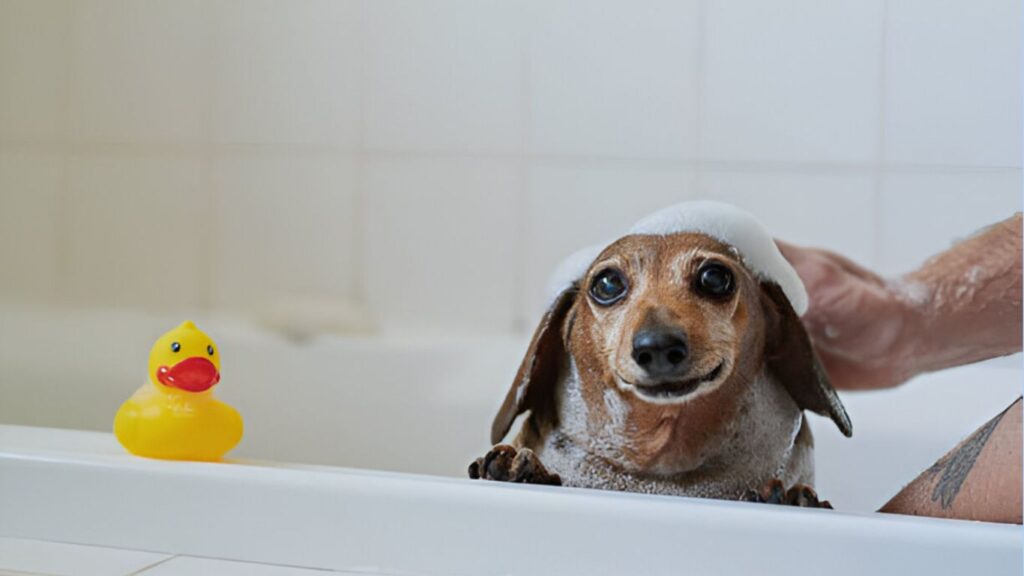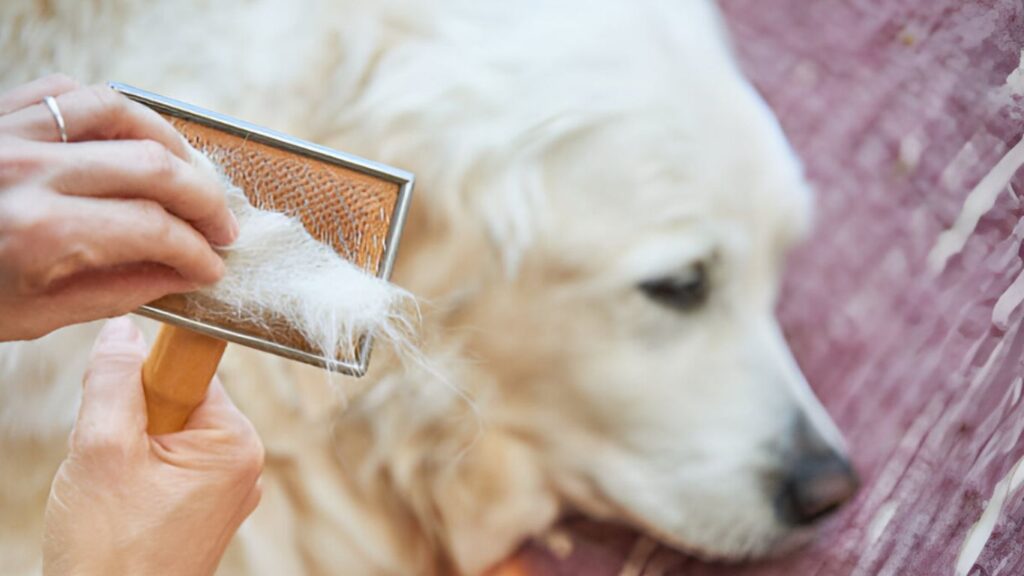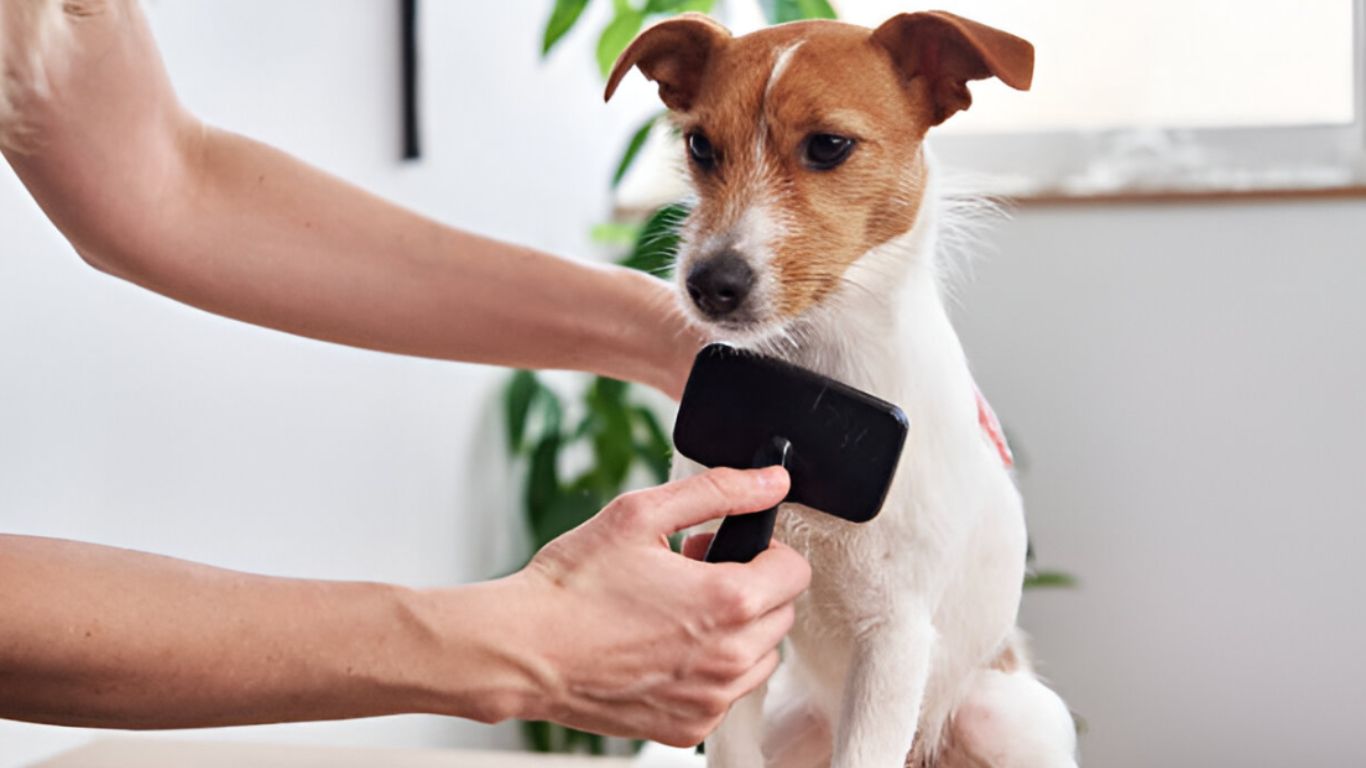A dog’s coat may be shaved or trimmed for various reasons, such as following surgery, medical procedures, or due to severe fur matting. Additionally, you may opt for a close trim to make your dog’s longer coat more manageable. Regardless of the reason, it’s natural to become concerned when your dog’s hair doesn’t seem to grow back as quickly as you expected. This leads to the question: how fast does dog hair grow, and what factors influence this process?
Goldendoodles have unique coats that require regular maintenance. Check out this step-by-step guide to deshedding short-haired dogs to keep your pet’s fur tangle-free and healthy.
How Long Does It Take for Dog Hair to Grow Back After Being Shaved?
So, how fast does dog hair grow? On average, dog fur that has been shaved to the skin typically takes about 3 to 4 months to grow back fully. This duration is approximately the length of a season, meaning if your dog is shaved at the start of spring, their coat should return to its normal length by early summer. However, this is a general estimate, and the actual time can vary based on several factors, including the type of coat your dog has and their overall health. Learn more about Why Does My Dog Dislike Brushing?.
Factors That Affect Dog Hair Growth | 8 Factors
Dog hair growth is influenced by several factors, including coat type, genetics, age, health, nutrition, and environmental conditions. Understanding these can help manage and support healthy regrowth after shaving.

1. Coat Length
The length of your dog’s coat plays a significant role in how quickly it grows back. If you’re wondering, How Fast Does Dog Hair Grow, short-haired dogs like American Pit Bull Terriers or Jack Russells usually regain their full coat within six weeks to two months. On the other hand, long-haired breeds, such as Afghan Hounds, may take up to two years to fully regrow their coat after shaving.
2. Coat Type
Single-coated dogs with short or medium hair generally experience faster regrowth, typically within six weeks to 3 months. However, double-coated breeds, such as German Shepherds, Huskies, and Retrievers, face a more complex regrowth process. While the undercoat often grows back within a season, the outer guard hairs can take up to a year, sometimes leading to a patchy or uneven coat if the undercoat crowds out the guard hairs.
3. Genetics
Certain breeds are genetically predisposed to slower hair growth or conditions like alopecia, which can significantly affect how quickly their coat grows back. Breeds with naturally sparse or hairless patches, or those prone to inherited skin disorders, may experience slower regrowth.
4. Age
As dogs age, their hair growth cycle may shorten, making it more challenging to regrow a full coat. Puppies also shed their initial coat as they mature, which can temporarily affect the appearance and texture of their fur.
5. Hormonal Influences
Fluctuations in hormones, particularly sex hormones, can impact hair growth. Pregnant dogs may experience temporary hair loss, and certain hormonal imbalances can lead to conditions like sex hormone alopecia.
6. Body Region
The location on your dog’s body where the hair was shaved also affects regrowth. Areas with naturally shorter hair, such as the legs, tend to regrow faster than regions with longer or thicker fur.
7. Stress and Anxiety
Your dog’s nervous system can influence hair growth through stress hormones and immune responses. Chronic stress or anxiety may hinder hair regrowth, so managing your dog’s stress levels is crucial for maintaining a healthy coat.
8. Health and Nutrition
Underlying health issues, such as hypothyroidism, diabetes, or Cushing’s disease, can interfere with hair regrowth. A balanced diet rich in essential nutrients is also vital for promoting healthy hair growth. Deficiencies in vitamins, minerals, or fatty acids can lead to poor coat quality and slower regrowth.
The environment in which your dog lives can impact hair regrowth. Seasonal changes, temperature, grooming frequency, and exposure to friction (from lying on hard surfaces, for example) can all influence the speed of hair recovery after shaving. Research indicates that dog hair grows fastest in the fall and slowest in the winter, aligning with the natural cycle of preparing for colder weather. Explore the Shepherd Fur Brush for keeping their thick fur in top condition.
How Can You Help Your Dog’s Hair Grow Faster?
When your dog’s coat isn’t growing back as quickly as you’d like, it can be concerning, especially if their fur was shaved due to surgery, a medical condition, or grooming. While time is a crucial factor in hair regrowth, there are several proactive steps you can take to support and potentially speed up the process. From proper grooming techniques to ensuring optimal nutrition, here’s how you can help your dog’s hair grow back faster and healthier.

1. Use a High-Quality, Gentle Shampoo
The type of shampoo you use on your dog plays a significant role in maintaining the health of their skin and coat. Opt for a gentle, hypoallergenic shampoo specifically formulated for dogs. Avoid using human shampoos, as they can be too harsh and strip away the natural oils that are essential for healthy hair growth.
Shampoos containing aloe vera are particularly beneficial. Aloe vera is rich in vitamins A, C, and E, which nourish hair follicles and promote healthy growth. Additionally, aloe contains proteolytic enzymes that help repair dead skin cells, creating a healthier environment for hair to regrow.
Oatmeal-based shampoos are another excellent choice, especially for dogs with sensitive skin. Oatmeal soothes the skin, reduces inflammation, and helps maintain the skin’s natural moisture barrier, which is essential for hair health.
2. Regular Grooming and Brushing
Brushing your dog’s coat regularly is crucial for maintaining healthy hair and promoting regrowth. Regular grooming helps to evenly distribute the natural oils produced by your dog’s skin, which are vital for keeping their hair moisturized and shiny. These oils nourish the hair shaft and protect it from becoming dry and brittle.
For dogs with short coats, a gentle brushing every few days is sufficient. However, long-haired or double-coated breeds may require daily brushing to prevent tangles and mats, which can impede hair growth.
When brushing, use a brush appropriate for your dog’s coat type. A slicker brush is ideal for removing loose fur and preventing mats in long-haired dogs, while a bristle brush works well for short-haired breeds. Be gentle to avoid irritating the skin, and take your time to ensure that you cover all areas of your dog’s coat.
3. Manage Stress and Anxiety
Stress and anxiety can significantly impact your dog’s overall health, including hair growth. The nervous system influences hair growth through stress hormones and immune responses. Prolonged stress can lead to hair loss or slow regrowth, as the body may prioritize other functions over hair production.
To manage your dog’s stress, identify and eliminate stressors from its environment. These could include loud noises, changes in routine, or separation anxiety. Providing a calm, stable environment and ensuring your dog gets plenty of exercise and mental stimulation can also help reduce stress levels.
If your dog suffers from chronic anxiety, consider consulting a veterinarian or a certified animal behaviorist. They can recommend strategies or treatments, such as behavioral therapy or calming supplements, to help your dog feel more relaxed.
4. Ensure Proper Nutrition
Nutrition is a cornerstone of healthy hair growth. A well-balanced diet rich in essential nutrients can make a significant difference in how quickly and healthily your dog’s coat grows back.
- Omega-3 Fatty Acids: Omega-3 fatty acids, particularly DHA and EPA, are crucial for maintaining a healthy coat. They help reduce inflammation, improve skin health, and promote hair growth. Fish oil, particularly from salmon or krill, is an excellent source of these fatty acids. Be cautious with plant-based omega-3 sources like flaxseed oil, as they contain ALA, which is less bioavailable for dogs compared to DHA and EPA from fish.
- Zinc: Zinc is vital for healthy skin and coat. A deficiency in zinc can lead to hair loss and poor coat quality. Large-breed puppies and Arctic breeds are especially prone to zinc deficiency and may benefit from zinc methionine supplements.
- Vitamins A and E: Vitamin A supports skin health and hair growth, but it should be administered with caution, as excessive vitamin A can lead to toxicity. Vitamin E is an antioxidant that helps protect cells from oxidative damage, promoting overall skin and coat health.
- B Vitamins: B vitamins, including biotin (B7), pantothenic acid (B5), and niacinamide (B3), are essential for hair health. They support the production of keratin, the protein that makes up your dog’s hair.
- High-Quality Protein: A diet rich in high-quality protein is essential for hair growth, as hair is primarily composed of protein. Ensure your dog’s diet includes around 25-35% protein, depending on their individual needs and any health conditions they may have.
Consider adding supplements to your dog’s diet if their regular food does not provide adequate levels of these nutrients. Always consult your veterinarian before introducing any new supplements to ensure they’re appropriate for your dog’s specific health needs.
5. Promote Circulation and Skin Health
Good circulation is crucial for delivering the nutrients needed for hair growth to the skin and hair follicles. There are several ways you can help promote circulation in your dog:
- Regular Exercise: Exercise is not only good for your dog’s overall health, but it also promotes healthy blood flow. Regular walks, playtime, and activities like swimming can help keep the blood circulating, ensuring that nutrients reach the hair follicles.
- Massage: Gently massaging your dog’s skin can stimulate blood flow to the area, encouraging hair growth. Use your fingertips to apply light pressure in circular motions, focusing on areas where hair growth is slower. This can also be a calming activity that strengthens your bond with your dog.
- Hydrotherapy: If available, hydrotherapy can be a great way to boost circulation. Swimming in warm water or using an underwater treadmill can help stimulate blood flow and improve overall skin health. Find a Heavy Coat Dog Brush to manage shedding and maintain a healthy coat effectively.
Post-Clipping Alopecia: When Hair Doesn’t Grow Back
In some cases, dog hair may not grow back after clipping, even after 9 to 12 months. This condition, known as post-clipping alopecia, is most common in Arctic breeds, such as Huskies and Malamutes. If your dog’s coat isn’t regrowing as expected, it’s essential to consult a veterinarian to rule out underlying health issues, such as Cushing’s disease or hypothyroidism.

If no medical condition is identified, treatments such as melatonin or levothyroxine may be recommended to stimulate hair growth. Your vet can guide the appropriate treatment based on your dog’s specific needs.
Final Thoughts:
The rate at which dog hair grows back after shaving varies widely depending on factors like coat type, health, age, and environmental conditions. While most dogs will see full regrowth within six weeks to 4 months, some may take longer, especially those with long or double coats. Understanding these factors and taking proactive steps to support your dog’s coat health can help ensure that their fur grows back healthy and strong. Hopefully, now you know how quickly dog hair grows.




